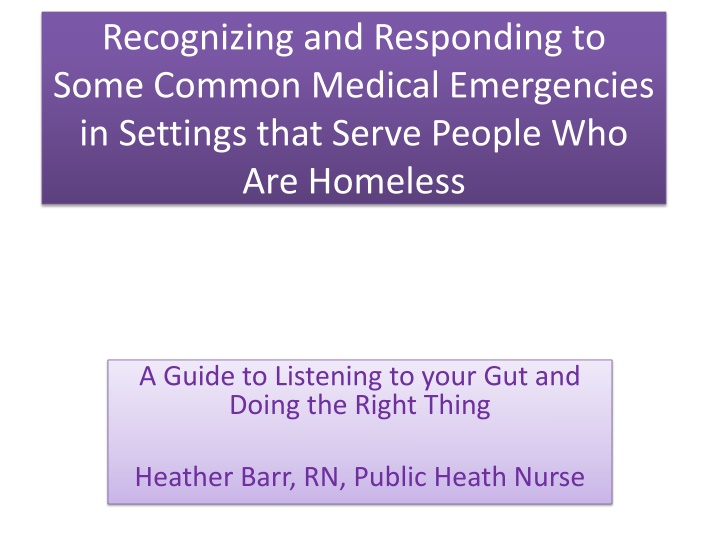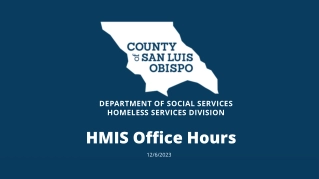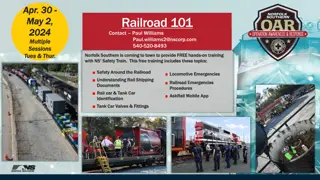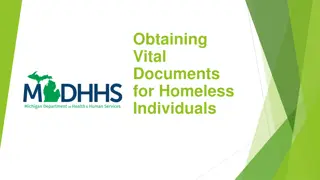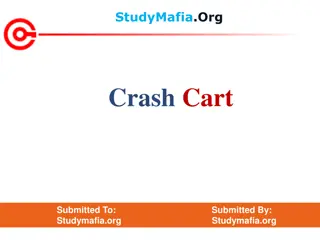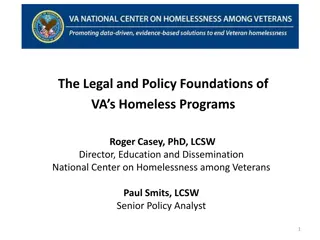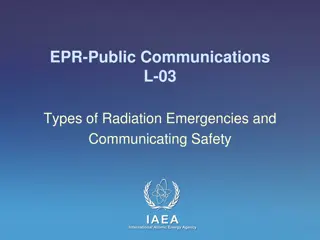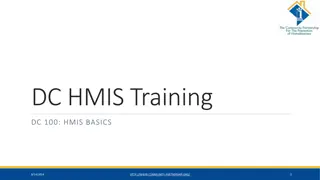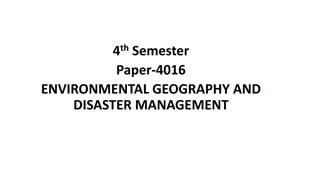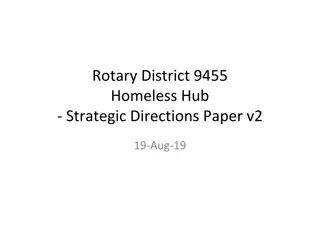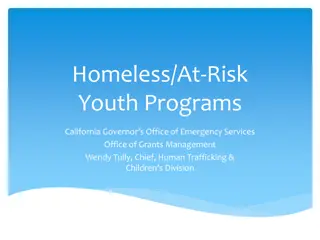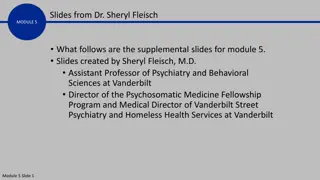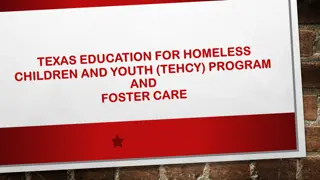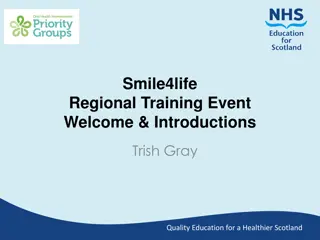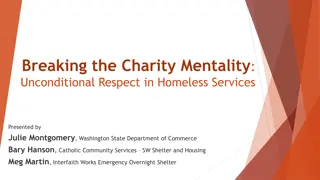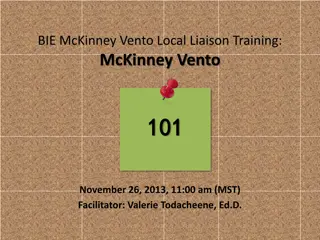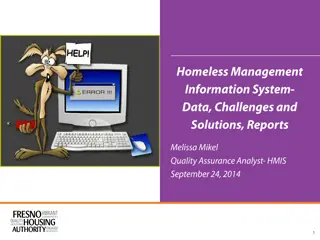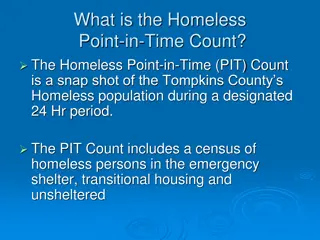Recognizing and Responding to Medical Emergencies in Homeless Settings
Guide by Heather Barr, RN, for non-medical individuals working with the homeless on spotting and handling medical emergencies. Covers understanding vulnerabilities, remaining calm, using trauma-informed care, and Good Samaritan laws to aid effectively while staying legally protected.
Download Presentation

Please find below an Image/Link to download the presentation.
The content on the website is provided AS IS for your information and personal use only. It may not be sold, licensed, or shared on other websites without obtaining consent from the author.If you encounter any issues during the download, it is possible that the publisher has removed the file from their server.
You are allowed to download the files provided on this website for personal or commercial use, subject to the condition that they are used lawfully. All files are the property of their respective owners.
The content on the website is provided AS IS for your information and personal use only. It may not be sold, licensed, or shared on other websites without obtaining consent from the author.
E N D
Presentation Transcript
Recognizing and Responding to Some Common Medical Emergencies in Settings that Serve People Who Are Homeless A Guide to Listening to your Gut and Doing the Right Thing Heather Barr, RN, Public Heath Nurse
Audience No medical or nursing background Or, if you have some kind of training this is a review Germane to the settings serving people who are homeless
Medical Emergencies Is this First Aid for Mountaineers? No. No broken bones, tourniquets, Splints. This training is about feeling a little more comfortable recognizing when a person is having a medical emergency and feeling a bit more confident in offering help, comfort and advocacy .
What you will learn about today Why this population is medically vulnerable Why you re especially able to recognize & respond effectively in medical emergencies. Tips for staying calm, remaining present Using Trauma Informed Care in medical emergencies Communicating with 911 What to do- a few very practical skills Some usual suspects-typical emergencies, or symptoms of potential emergency Good Samaritan Law
Good Samaritan Laws Protect those who do offer aid subsequent protection against legal action. As long as the rescuer is not willfully negligent or reckless in giving aid, and gives aid in a reasonable manner, then the rescuer will not be held legally liable for the outcome. Note that if a victim refuses assistance, forcing help on them against their wishes does not offer the rescuer shelter from legal liability. In this case, the rescuer should phone 911 immediately and let police and/or medical personnel handle the situation.
Remember, render help that is commensurate with your training.
Why youve got this. You are an advocate, you have special understanding of and knowledge about the people in your care and their challenges in life. What you know is important. You know your own personal abilities & limitations You can be a clear, intentional, confident, committed advocate.
What makes the people you work with more vulnerable in medical emergencies?
Special Considerations Histories of Trauma Mental health issues Substance use issues May not respond to pain in typical way May have communication problems May be in very poor health at baseline Possible bad past experiences with EMS, Law Enforcement, hospitals (possible trauma triggers) May be alone.
The person may need advocacy -why? May present a complicated picture to EMS May be misinterpreted/ misunderstood by EMS, police, medical staff, others (misidentified as intoxicated, other misperceptions) May have a complex medical history with or without diagnosis or treatment May be alone, may be unknown to you, too
Why are you such an important and valuable advocate? You know about the impact of trauma You might know about the person s medical history You might know what the person looks like on a good day, and recognize a change in behavior, health. You can attest to a change . You know more about substance use, mental illness and homelessness than most You stand up for people on a daily basis. You can help others understand this person, especially if you know them, and even if you don t
Trauma Informed Care Understand trauma triggers (pain, noise, people, sirens, medical situations) Do no harm, avoid re-traumatizing Know some ways to mediate the traumatic effect of the current situation Get person s permission to intervene, provide care Provide safety physical and emotional/psychological, Offer limited choices, give some kind of control, provide safety, physical and emotional/psychological, But act on behalf of people when they unable to speak or care for themselves or when they are alone
How Can I Stay (or become ) Calm in an Emergency? What helps you remain calm? What is your experience with medical emergencies/situations? Have you had first aid or CPR training?
Calm yourself Take a deep breath, decide and commit Take a few seconds to assess the situation. What s happening? Is it safe to intervene? DO NOT BECOME ANOTHER EMERGENCY Who is available to help, standby and or dispatch Check the time, ask someone the time
Feel Prepared: equipment Have a mini kit: Watch or time piece Cell phone Gloves Rescue breathing shield Note pad, pen Naloxone Soft candy or glucose tabs
Feel Prepared Run scenarios in your mind, watch videos Do case staffings before and after emergencies Have good medical intake forms, and know your clients who frequently need ambulance, have chronic conditions, EOL DNR Advance Directive Run practice drills frequently. Take a First Aid Class Update your CPR Do de-briefing after any emergency at your agency
Feel Prepared Remember the important thing is comforting and advocating Remind yourself about being a comforting voice to a person in crisis. Don t be nervous about not knowing everything (no one does)
Speed of the event Some emergencies unfold over time, fever, infections may start slowly and reach emergency level in a matter of hours A person with untreated or poorly controlled diabetes may take days to reach an emergency level Worsening chronic conditions may take time to notice A person with a head injury may not present with symptoms hours after the incident.
In a matter of seconds Notice the oh-oh feeling : Listen to that, it is your gut feeling and it is usually right The brain would like for everything to be OK, so it may feed you some bad info. Inform your brain that you need it to act right now. Focus on what you are picking up on, what has alerted you What do you see? (Objective data)We call these things signs. What is the person telling you? (Subjective data) We call those symptoms. Tell yourself to pay attention to signs and symptoms Prepare to take charge
Many emergencies have similar signs Behavior is odd, not the usual, or unsafe Extreme agitation Extreme lethargy Very upset, appears frightened Seems confused, not making sense Speaking slurred, strange, too loud, too quiet Weak, unable hold object, squeeze hand, raise limb Walking is unusual, staggering, slow, guarded Guarding a body part or area of the body Moving erratically or very slowly Breathing is fast, slow or loud Skin looks pale, Skin looks flushed Heart rate is fast or slow, or irregular Not responding Changes in consciousness/mentation/behavior/personality
The signs are things you notice Signs get your attention. That s good! Try not to diagnose, just pay attention to the signs and describe what you notice. Treatment is based on signs, clusters of signs
Pediatric Signs Change in eating, nursing Vomiting Decreased or absent urine output Change in skin flushed, pale, blotchy Change in lip/facial color- pale or bluish tinge Change in behavior, playing Change in mood Inconsolable crying Agitation, lethargy, increased fussiness Complain of pain, not feeling well
Simple Skill: A B C Airway clear and protect Breathing be ready to assisit Circulation check the pulse In any emergency, always be assessing these continually.
Many emergencies have the same or similar symptoms (feelings, complaints) I feel Sick, feel awful, feel funny, f ed up, scared Nauseous Pain Weak Tired Cold, hot Can t see, can move, can t feel, can t talk
Action and Assessment You have to quickly build trust. What helps that happen quickly? Tell them who you are, what you can do, can t do. Your intention to help Hi, looks like you are having some trouble; I m Joe, and want to help you, OK? Reassure, caring, confidence, steadfastness, follow-thru: I m going to stay with you till the EMT s get here. Want to make sure you are safe, alright? Take charge, clear the area, (safety) secure the area enlist help, I am concerned about you, can you tell me what s happening, what do you think is going on? Gather a little very useful more information. The person, friends, witnesses. This is helpful if the person might lose consciousness before help arrives. Explain to the person why you think 911 is a good idea
General Information you could ask for What happened? Let the person speak, listen for clues Name and DOB if possible Where do you usually go to the doctor? Been there lately? Do you take medication for anything? Have you taken any kind of drugs? Alcohol? Have another person ask witnesses what they saw.
What are some examples of medical emergencies? Seizure Stroke Diabetic emergency Overdose Alcohol withdrawal Shock Trouble breathing, asthma Allergic reaction Heat and Cold emergencies Injuries: broken bones, strains, sprains, cuts, head injuries Heart attack Poisoning Sepsis, overwhelming infections, bad wounds Dehydration Abdominal pain Chest pain Loss of consciousness Psychiatric emergency Assault Rape
Common Pediatric Medical Emergencies Fever Seizure Meningitis Allergic Reaction Poisoning Asthma attack Croup Vomiting and Diarrhea
Call 911 My name is:___________ I am at _(address, cross street, landmark) There is a person here who is having a medical emergency He is (brief demographic) name 45 -55 year old male, known as Benny, Benjamin Burt Describe what you saw found on the ground What he is doing (breathing shallow, not responding) What he said/complained about (friend said he said Oh, god, and then fell) What you (and co-worker, other volunteer)are doing now (checking if he is breathing, giving rescue breaths, asking his friend what else happened
Some Specific Medical Emergencies typically seen in settings like yours
What we will cover today: Seizure Stroke Diabetic emergency Overdose Alcohol withdrawal Shock
Seizure Disruption in the brain s electrical activity Caused by infection, injury, drugs, epilepsy, head injury, stroke, tumor Person may seem out of it , stop talking, stare, wander. They may not speak, but could be aware. Person may have odd or violent movements, fall down, lose consciousness, make sounds, have breathing difficulty. Usually brief, call 911 if lasts longer than 5 minutes in any case
Seizure-timing, prevent injury, comfort Note time seizure began, time it. Over 5 min? Remain calm, ask for help keeping the person safe, out of harm s way, move furniture, get a blanket, keep people away. Calmly and constantly reassure Ease the person down, positioned on side, (rescue position) mouth toward ground, move away from danger, furniture, cushion head. Provide privacy. Calmly tell the person you will stay with them till they recover.
Is this person known to you? Intake information- medications, Health Care Provider, typical type of seizure, plan of care, when to call 911 Provide medical background information to EMS
Call 911? If this is their first seizure If they seize again If they have had seizures before, but have never been seen by health care provider If this seizure lasted 5 minutes or longer If they were injured during the seizure If they were recently injured, especially Head injury If they are possibly in alcohol withdrawal If they request it
Is this person not known by your or agency? Because you don t know their background, you should call 911 for them. You don t know why they had a seizure. They can negotiate with 911 when they are alert.
Post- seizure Comfort Orient Reassure Offer face cloth, tissues, water, help change clothes if needed Provide privacy Allow for rest Talk about plan for next time Offer assistance with arranging follow up care if appropriate. If client is transported, call to check on them if they are your client
Seizure Care Skills Review Time check at start of seizure or when you notice something is wrong Comfort, calm, care, safety Position in recovery position- comfort, airway Monitor breathing- if tonic/clonic, may have short cessation of breathing. Privacy Stay with them till EMS arrives or until they regain awareness, alertness if they have seizures like this typically and are known to you
Dont do these Don t put anything in the person s mouth. Don t worry about swallowing the tongue . Don t restrain. Don t ask a lot of questions.
Everyday First Aid- Seizure https://www.youtube.com/watch?v=7MPJauo 4DdY
Recovery Position http://www.youtube.com/watch?v=uCDa- AhrjHo
Stroke Hemorrhagic, or bleeding stroke, Due to long standing uncontrolled high blood pressure, damage to the blood vessels, resulting in a burst blood vessel Ischemic- blocked blood flow due to clot Disrupted blood flow deprives the brain of oxygen and nutrients.
Stroke is a disruption in blood flow to the brain resulting in a sudden impairment in brain function Aneurysm Blood clot Embolism Atrial Venous Malformation
Stroke Signs and Symptoms Dizziness Headache-often sudden worst headache Vision changes, one or both eyes Weakness, numbness on one side Paralysis, unable to move one side of the body Dizziness, trouble walking, balance is off Slurred speech, trouble talking Trouble understanding, confusion Seizure Loss of consciousness
Stroke facts 4thleading cause of death, 133,000 a year die 795,000 strokes per year one every 40 seconds Twice as many women die of stroke that breast cancer 80% are preventable
Risk Factors Same as heart risks, damage to arteries, clogging of vessels. Smoking, diet, exercise, some drugs, previous history of a stroke
FAST FACE- droopy ARM- weak S- Speech T- Time- call 911
